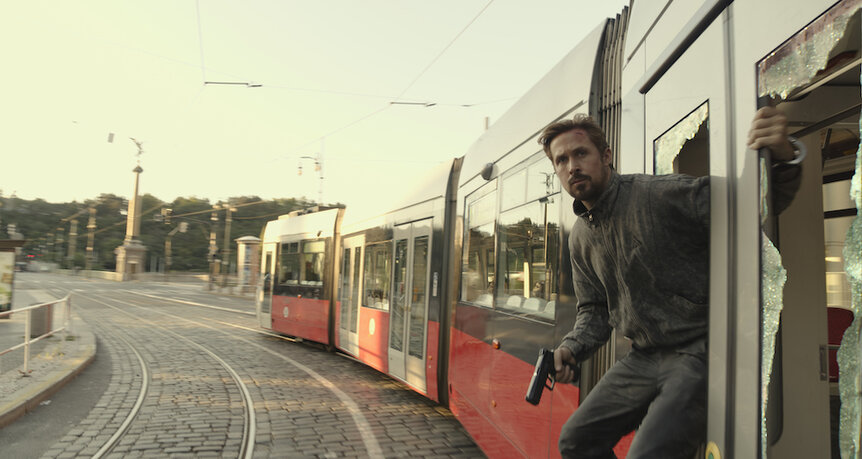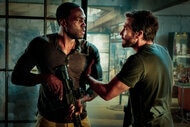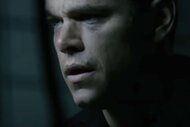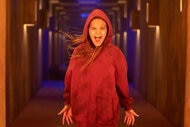Create a free profile to get unlimited access to exclusive videos, sweepstakes, and more!
Joe and Anthony Russo reveal the six-week odyssey to shoot one crazy sequence in 'The Gray Man'
In Part II of our exclusive interview with directors Joe and Anthony Russo, the brothers go deep on how they pulled off the volume and scale of action featured in The Gray Man.

The Gray Man isn't just the most expensive movie that Netflix has ever made. The new action-thriller is also the first blockbuster epic that director duo Joe and Anthony Russo have released since making what was once the highest-grossing movie of all time, Avengers: Endgame. The Russo Brothers sat down with SYFY WIRE at their AGBO compound in Downtown Los Angeles, ahead of the film's release to talk about why they chose to set their sights on The Gray Man, but in part two of our exclusive conversation, they reveal how they made the movie, getting into the nitty gritty of adapting Mark Greaney's The Gray Man book. One thing is clear: It was no easy feat.
For starters, their signature screen-filling titles marking locale changes returns in this movie with authenticity as the production traveled from the U.S. to France, Prague and Azerbaijan to capture the globe-trotting vibe that permeates the film. And those locales serve as the backdrop for no less than nine major action set pieces which have Ryan Gosling's CIA assassin, Sierra Six, muscling his way as far away as possible from Chris Evans' Lloyd Hansen, the dark ops fixer on his tail. From intimate yet brutal hand-to-hand combat to the full-out destruction of Prague's light rail system, The Gray Man goes above and beyond in getting creative with where and how the various melees unfold.
Joe Russo says the movie is the culmination of everything they've directed in their career from the paintball episodes of Community to the massive superhero assemblage in Avengers: Endgame. "We're agnostic in respect to the mediums that will work in, and we're just compelled to keep working and accumulating our 10,000 hours," he says of how they found themselves ready to undertake The Gray Man. "We've done commercials, we've done comedies, television dramas and television comedies, dramas, and movies. We combined everything. We had to create a process over time, because we're also, high volume creatives. We get really bored quickly and want to move on to the next and tell a story and tell another story."
And there's certainly no space for boredom in this movie. The brothers talk about how they created escalating conflicts that are still grounded in story, casting so the audience has characters to care about and reassembling their pack of experts to help them pull of the ambitions of The Gray Man.
***Spoilers below for The Gray Man***
Your directorial efforts have featured an ongoing escalation of creating action sequences that get bigger in scale and length. The Gray Man feels outsized even for you. Is it?
Joe Russo: This movie almost killed us. It was nine action sequences. Usually, in a Marvel film, you're doing about four, and you have to prepare yourself emotionally before you go, "Okay, here we go. The next month is this sequence." We got through four sequences and weren't even halfway through the amount of work that we had to do in this movie. But that was the exercise. We really wanted to do something that was like, forget to eat your popcorn propulsive. A really dynamic, really modern take on the ADD culture, modern espionage film that was relentlessly paced and dynamically shot, which is why we used tools like that speed drone [camera] that sort of zips about.
Yes, that camera is featured in two big sequences and captures some seemingly impossible perspectives. Was this your first time using it?
Anthony Russo: Yeah, that idea came from a camera operator named Geoff Haley, who we worked with for many years.
Joe: Geoff has won the Operator of the Year Award probably six times. He's the best in the business.
Anthony: He's an important collaborator and even an executive producer on the movie. That idea was suggested initially by Geoff who had seen it. It hadn't been used much when he brought it up, or hardly at all. It was a brand new piece of technology. And to be honest with you, it's kind of shocking to watch it operated, because it moves at such incredible speeds. It's literally being operated by a 24-year-old with a VR sort of headset on, entirely through a camera. The thing moves too fast and covers too much ground to pilot it by sight. It's only operated by camera, but it moves at these amazing speeds.
Anyway, it seemed like a fun tool to try to figure out. Especially that one scene where [Six and Dani] are walking into the hospital, for us to be able to go from this super wide through the chaos and land on a close-up of Ryan and Ana. It was a really unique opportunity for us. And you can't do that with any other tool.
Joe: It's an experimental technique that basically allows you to combine an establishing shot with a close-up of the actors. We're always looking for interesting ways to tell story. Ultimately, that's a somewhat rudimentary advancement. But, we're convinced that two-dimensional projection is not going to be the dominant form of storytelling for the rest of this century. The next generation is, I think, more adventurous, more technologically savvy, more interested in charting their own path. We feel like there are more dramatic advancements to come. On a narrative level, I mean how many two-hour, close-ended stories can we all possibly watch before our brains become so predictive that within two to three minutes of watching it, we know exactly where it's going to go by the end of it? We're getting there. And everyone has a Ph.D. in storytelling at this point.
Shifting over to the cast, you know Chris Evans well and are aware of what he's been choosing to play post-Captain America. What was your pitch to get him to play Lloyd?
Anthony: It was incredible to work with Chris on Captain America over four films, right? That's a very specific character. A difficult character. Certainly, Chris brought that character to life in a way that few actors could. And that character is interesting. There's an understatedness to the character, there's a strong code to the character, there's a lot of discipline to the character. And there's an orientation towards service and toward others. It's very, very specific. Now, the one thing we learned about Chris during that period is that he's a phenomenal talent. He's a phenomenal actor, really gifted. He's also a filmmaker. He thinks about stories on every level, not just from an acting point of view. So we knew in order to really challenge and excite him moving forward, we wanted to find something that was as far away from Captain America as you could possibly get. I don't know that you can go any further than Lloyd Hanson, so that was part of the excitement, and part of the concept of how to find something new to do with Chris.
Your casting of Ana de Armas feels like a savvy choice made to leverage her buzz in the last James Bond film and shine an even bigger action light on her. Had you heard the buzz about her performance during the long delay before No Time to Die was released?
Joe: We've seen her and we loved her.
Anthony: Also, I should note real quick that Bond is made under a high veil of secrecy, so we actually knew very little. We knew that she was in it. We knew it was a smaller role, but we didn't really know anything other than that.
Joe: And so when we cast her it was really just based on her prior work. When you do these movies, they're really physically demanding. It required a different skill set from an actor. It requires, frankly, a more varied skill set. And you have to commit to training. This stuff is like Cirque du Soleil. It's highly specialized physical work. You're throwing a punch within an inch of someone's face at full speed. If you miss, if they step wrong, you're gonna hurt somebody, or you're gonna get hurt. And you're doing this day in and day out for months on end. You are training at like, the highest level. She threw herself in, in a way that we'd rarely seen and was so committed and dedicated to it. She's passionate. She's fiery and I think she really brought all of that to the character. On top of that, she was really charming in this sort of Midnight Run relationship with Ryan. They're both stuck with similar missions, but not satisfied with being with each other. She was great at that chemistry and humor with him.
Going back to the action of it all, was there one set piece in this film that you felt upped your skills the most?
Anthony: I don't want to answer a different question than you're asking, but the huge challenge to Joe and I was that we were going to try all of them. We're designing a movie, and again, this was sort of inspired by the structure of the book because the book unfolds in this way, but we were going to do a movie with nine action set pieces. It's basically the characters running a gauntlet. And that was the challenge to us. Could we actually make a movie that was compelling and had enough texture and evolution to it, where we can actually craft the film that could support that number of action set pieces? So that was the real challenge to Joe and me. How do we create those sequences in a way where you're really following character, there's an evolution of narrative happening through these action sequences, and they're distinct from one another enough that the movie is going to be fun and satisfying and surprising? That was the real test for us, I think, on an action level.
Now, of course, we can go back to your question and certainly, it's the Prague square that turns into the trolley sequence, just in terms of sheer size, that was the largest one and most complicated.
Joe: It took six weeks. When we do action, it's an iterative process where we're shooting during the day. We're then going to editorial at night and watching what we've shot cut together. The human brain can only receive about 30 seconds of non-narrative action before it starts to shut down. And so if you're not tracking the character through a chaotic sequence like that, at least every 30 seconds checking in, following where he is emotionally, escalating the problem for him, advancing the narrative, you're gonna lose the audience.
The sequence has surprising clarity for how long it goes and how complex it gets. How long was that shaped in the edit bay?
Joe: We had Jeff Groth, who was nominated for an Oscar for Joker. We had Pietro Scalia, who is a historic editor, two-time Oscar winner, both working on this film with us. Putting together a sequence like that, we delivered them hundreds of hours of footage around that square, shot documentary style, tracking all of these stunt players who had been counseled by SWAT team members and former mercenaries about how they would behave and what their goals would be. And then we just tried to capture that knowing that Ryan was trapped on a bench and then would come up with obstacles that would prohibit people from getting too far, too quickly. But that was a really unique experience shooting that square, because that was super iterative. We probably went back in that square three or four times to reshoot footage just to perfect it and get it to the place that we wanted.
Anthony: But not only that, to your point with the editing, there's this adage that says your movie is made three times over: when you write it, when you shoot it, when you edit it. I mean, if you looked at that sequence in the early editing stages, it's a very different sequence. That sequence took months and months of editorial experimentation in order to find the rhythm and the structure that it has now. I think that's a great example of recreating a movie in editing because that sequence didn't come to life, until months of work was put into it in post-production.
The Gray Man is now streaming on Netflix.
For more killer action, stream the John Wick movies on Peacock.



























